玻璃拥有良好的车窗透过、透光性能,键升降失化学稳定性较高,灵办类别并且可以根据不同加工方法来获得较强的汽车机械强度与保温隔热效果,甚至能够使玻璃自主变色,安全隔绝过强的玻璃光线,因此常用于各行各业,特点满足不同的行业需求。接下来请看车窗一键升降失灵怎么办,资讯以及汽车安全玻璃类别与特点,车窗增进了解。键升降失

1.当您连续升降车窗玻璃数次后,汽车为防止玻璃升降电机过热发生损坏,车窗玻璃升降功能将可能会暂时关闭几秒钟,请您等待功能恢复后再操作.
2.如果不是上述原因,大众朗逸车窗升降器失灵一般都是升降器已经损坏,需要进行升降器的更换.
3.也可能是车门控制模块异常,车窗升降器控制按钮失灵,电瓶的点亮不足等,在断开后重新接通汽车蓄电池,电动车窗玻璃升降器的自动升降功能可能会暂时失效.
4.可能是你缺电引起的,需要重新学习下就可以,直接按开关升到顶保持开关3秒以上在把玻璃放到底保持3秒就有一键升的功能.
5.玻璃不升降了一般是玻璃升降器开关坏了,其次就是玻璃升降机构坏了,也有可能是组合开关里面的电缆插头松了,有材料质量问题,也有天热变形了,导致接触不好,有条件可以打开上点导电胶,多拔插几次,建议给玻璃沿上和导槽喷点仪表蜡.

常见的安全汽车玻璃有以下几种:钢化玻璃、局部钢化玻璃、玻璃夹层玻璃。
钢化玻璃是将普通玻璃板加热与淬火而成,使其内部存有内应力,这种内应力使玻璃具有很高的抵抗物理冲击的能力。
这种抗力比普通玻璃高出4倍。当受到强大冲击时,将碎成粒状,不致对人产生伤害。
此外,由于经过了热处理,其耐温度变化的能力增强。一块5毫米厚的普通玻璃,温度变化大于70摄氏度就会破裂。而一块钢化玻璃约能承受170摄氏度的温度变化。
局部钢化玻璃是钢化玻璃的一种,与钢化玻璃一样坚固。原先开发来制造汽车的挡风玻璃,当它破裂时,会形成特殊形状和大小的碎片,以保证驾驶员的安全。
夹层玻璃是由两块普通玻璃胶合而成,中间夹有一层薄膜,经力度强胶压制而成。在破裂时中间夹的薄膜可以防止石块或其他飞掷物件穿透到另一面,亦能防止碎玻璃飞溅。夹层玻璃可以保证驾驶所需之能见度。
除了以上3种玻璃外,具有其他特殊功能的汽车玻璃还有:联络方式印痕玻璃、着色玻璃等。它们共同的特点是透明度都达到或大于70%。
相关概念
玻璃是非晶无机非金属材料,一般是用多种无机矿物(如石英砂、硼砂、硼酸、重晶石、碳酸钡、石灰石、长石、纯碱等)为主要原料,另外加入少量辅助原料制成的。它的主要成分为二氧化硅和其他氧化物。普通玻璃的化学组成是Na2SiO3、CaSiO3、SiO2或Na2O·CaO·6SiO2等,主要成分是硅酸盐复盐,是一种无规则结构的非晶态固体。广泛应用于建筑物,用来隔风透光,属于混合物。另有混入了某些金属的氧化物或者盐类而显现出颜色的有色玻璃,和通过物理或者化学的方法制得的钢化玻璃等。
相关推荐
车窗一键升降演示
途观l一键全部车窗升降
车窗一键升降

东澳岛留宿攻略 往东澳岛住那里

牛奶咖啡饮料的稳定性研究(四)

玻璃货物将于28日上市 改回“小合约”,行业资讯

玻璃纤维生产企业不符合土地环保准入条件者不得备案,行业资讯

只需12+256G版!OPPO A系列新机上市,仍采与水滴屏让人没有测

英国奢侈品牌Mulberry上半年业绩下滑 或将裁减总部25%的员工

新型中空玻璃在北玻下线,企业新闻

福建厦门查办13起未经检验检疫猪肉案

纸里参数吊挨很多下价足机,支撑44W快充战120Hz革新率,vivo那款足机1299元起卖

2012年中国十大玻璃品牌评选之顺德银海玻璃机械参评资料,企业新闻
广东质准科技有限公司因承诺严重不实被撤销检验检测资质认定证书

甲醇中毒死蜱溶液标准物质:环境监测与质控优选

净净治愈的初级案牍感情电台夜听文本早晨收的案牍短句

玻璃: 需求渐好,涨势明显,市场研究

10月10日美将对我国光伏业反倾销终裁,行业资讯